|
|
The outrageous but bizarrely supportable thesis statement that I lay before you is this: The Star Wars saga symbolizes the history of Vatican II. For those unschooled in the ways of Star Wars and recent Church History, this may not interest you ... or will just be incoherent. But without further ado, let me start at the beginning, a long time ago, in an Ecumenical Council far, far away ... |
Anakin Skywalker is the Second Vatican Council
  The discovery of Anakin (the "Chosen One") by the Jedi and the convening of the Council by the Clergy are both surprising and seem to come out of nowhere, although at the same time everyone knew they had to come, as alluded to by the historical memoirs of Pius XII and the Jedi Prophecy. The Ecumenical Council was to "bring the Church into the Modern World," as the Chosen One is to "bring balance to the Force." Both of them go completely awry.
The discovery of Anakin (the "Chosen One") by the Jedi and the convening of the Council by the Clergy are both surprising and seem to come out of nowhere, although at the same time everyone knew they had to come, as alluded to by the historical memoirs of Pius XII and the Jedi Prophecy. The Ecumenical Council was to "bring the Church into the Modern World," as the Chosen One is to "bring balance to the Force." Both of them go completely awry.
|
Qui-Gon Jinn is Pope John XXIII
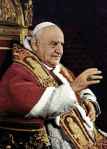 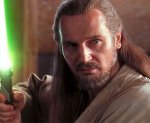 Qui-Gon Jinn, the main Jedi Master we are introduced to at the beginning of the saga, stumbles upon Anakin Skywalker, the Chosen One, just like John XXIII suddenly announced the opening of the 2nd Vatican Council. Also, Qui-Gon and John XXII both die at the outsets of their projects.
Qui-Gon Jinn, the main Jedi Master we are introduced to at the beginning of the saga, stumbles upon Anakin Skywalker, the Chosen One, just like John XXIII suddenly announced the opening of the 2nd Vatican Council. Also, Qui-Gon and John XXII both die at the outsets of their projects.
|
Obi-Wan Kenobi is Paul VI
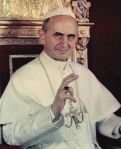  Both Obi-Wan and Paul VI set out to finish what their predecessors had begun. Both are known to be kind-hearted, holy individuals of competent learning who are, nonetheless, quite clueless as to what is happening to what they're in charge of.
Both Obi-Wan and Paul VI set out to finish what their predecessors had begun. Both are known to be kind-hearted, holy individuals of competent learning who are, nonetheless, quite clueless as to what is happening to what they're in charge of.
|
Emperor Palpatine/Sidious (or the Sith in general) is Modernism
  As Chancellor Palpatine works to manipulate Anakin to the dark side for his Sith-ruled galactic conquest, so did conniving modernists work in shadows to turn the Council to their evil agendas. Palpatine's modernist views are made explicit when, for example, in attempting to warp Anakin's mind, argues, "Good is a point of view."
As Chancellor Palpatine works to manipulate Anakin to the dark side for his Sith-ruled galactic conquest, so did conniving modernists work in shadows to turn the Council to their evil agendas. Palpatine's modernist views are made explicit when, for example, in attempting to warp Anakin's mind, argues, "Good is a point of view."
Similarly, Palpatine, when he was Chancellor of the Old Republic, can be seen as a kind of Liberal, who pretends to work for freedom, but in the end increases the size of government, taking away people's rights, and is very popular among freedom-loving Democrats for it.
|
Darth Maul is the Explicitly Satanic Prelude to Modernism
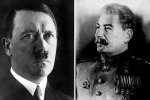  As Palpatine initially sends a very ostentatious disciple against the Jedi, so did modernism show a very obviously demonic face to the world, as was manifested, for example, in Nazism and Communism (two opposite but deadly extremes ... sort of like Maul's Double-Bladed Lightsaber, dare I say). However, both Palpatine and Modernism would then calculatingly change strategies and work more successful, subtle ways in undermining the Church.
As Palpatine initially sends a very ostentatious disciple against the Jedi, so did modernism show a very obviously demonic face to the world, as was manifested, for example, in Nazism and Communism (two opposite but deadly extremes ... sort of like Maul's Double-Bladed Lightsaber, dare I say). However, both Palpatine and Modernism would then calculatingly change strategies and work more successful, subtle ways in undermining the Church.
Qui-Gon Jinn was defeated by Darth Maul, showing the unpreparedness of the Jedi to the newly invigorated Sith, just as John XXIII failed to prepare the Church for the modern world due to his untimely death. Obi-Wan's defeat of Maul, while praiseworthy, did little to fix the more elusive elements of the Sith, just as Paul VI's accomplishments, many of which were good, did not sufficiently defend Catholicism against the new onslaught of modernist machination.
|
The Trade Federation is Capitalism (or Neo-Conservatism)
  Capitalists often pretend to entertain what the Popes have to say (particularly regarding Church social teaching), but in the end betray them, just as the Trade Federation, the largest commercial corporation in the Star War Universe, pretended to entertain Qui-Gon Jinn and Obi-Wan Kenobi who visited as diplomats but were then almost assassinated. The Neimoidians, the race of aliens heading the Trade Federation (chief among them being Viceroy Nute Gunray), furthermore, have stereotypical Oriental accents, which relate them to Japan and China, both of which became huge capitalist empires.
Capitalists often pretend to entertain what the Popes have to say (particularly regarding Church social teaching), but in the end betray them, just as the Trade Federation, the largest commercial corporation in the Star War Universe, pretended to entertain Qui-Gon Jinn and Obi-Wan Kenobi who visited as diplomats but were then almost assassinated. The Neimoidians, the race of aliens heading the Trade Federation (chief among them being Viceroy Nute Gunray), furthermore, have stereotypical Oriental accents, which relate them to Japan and China, both of which became huge capitalist empires.
The Trade Federation's greed spring-boards people to want greater government control in the Galactic Republic. And ironically, it was people in the government, namely Palpatine (Darth Sidious) that encouraged their greed so that this would happen. Similarly, the greed of the neocons (something that Capitalists often say is a virtue rather than a deadly sin) is often the catalyst for people wanting more government power in their lives, which, they think, will protect them from oppression by the wealthy. While the Trade Federation visibly opposed the Galactic Republic (which was, once again headed by Chancellor Palpatine), the Trade Federation ironically was getting their orders from Palpatine the whole time (who disguised himself as Darth Sidious). Likewise, many Capitalists unbeknownst to them are serving the same agenda as the Liberals (i.e. Modernism), though some are indeed aware of it, considering that many of the richest Capitalists in the world, in fact, are Liberals. Further, where there is big business (capitalism), you will find big government (socialism), which can be seen in the United States and, moreover, in China.
|
Jar-Jar Binks is a Stupid Catholic
  Jar-Jar Binks represents the really annoying, naive, wild, and even ethnic influences that drizzled into the liturgy and minds of Catholics and consequently empowered modernism to take more control, which is what happens in Episode II, when Jar-Jar is put in charge of Naboo Representation in the Senate and explicitly gives power over to the Supreme Chancellor, which enables Palpatine to secure his reign. Jar-Jar is evil.
Jar-Jar Binks represents the really annoying, naive, wild, and even ethnic influences that drizzled into the liturgy and minds of Catholics and consequently empowered modernism to take more control, which is what happens in Episode II, when Jar-Jar is put in charge of Naboo Representation in the Senate and explicitly gives power over to the Supreme Chancellor, which enables Palpatine to secure his reign. Jar-Jar is evil.
|
Count Dooku is a Liberal Priest/Bishop
 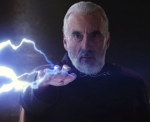 Dooku, having been an old, well-respected Jedi Master, turned to the dark side, as many Catholic Bishops (and notably Jesuits, who controlled lots of Catholic universities) just before and after Vatican II, turned modernist and liberal. Just as Dooku cut off Anakin's arm, so did clerical Judases help to maim the true nature of Vatican II.
Dooku, having been an old, well-respected Jedi Master, turned to the dark side, as many Catholic Bishops (and notably Jesuits, who controlled lots of Catholic universities) just before and after Vatican II, turned modernist and liberal. Just as Dooku cut off Anakin's arm, so did clerical Judases help to maim the true nature of Vatican II.
|
The Clone Wars are the Wars between Conservatives and Liberals
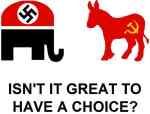  As alluded to before, the Galactic Republic (controlled by Chancellor Palpatine) and the Separatists/CIS (chief among them being the Trade Federation, who are controlled by Darth Sidious ... who is also Palpatine) are unknowingly serving the same master despite their hatred of each other. Palpatine uses the war to distract the Jedi from his plans of destroying them, converting Anakin, and taking over the galaxy. The conflict between the conservatives and the liberals, in comparison, is a useless war to distract us from the true plans of modernism. Despite how well-meaning and faithful they are, most Catholics tend to pledge allegiance to one side or the other and thus overlook the true evil at the heart of the modern situation. Both Capitalism and Socialism are modernist constructs that ought to be rejected ... both the Republicans and Democrats have done nothing to stop abortion (yeah, that's right, the Republicans haven't done anything).
As alluded to before, the Galactic Republic (controlled by Chancellor Palpatine) and the Separatists/CIS (chief among them being the Trade Federation, who are controlled by Darth Sidious ... who is also Palpatine) are unknowingly serving the same master despite their hatred of each other. Palpatine uses the war to distract the Jedi from his plans of destroying them, converting Anakin, and taking over the galaxy. The conflict between the conservatives and the liberals, in comparison, is a useless war to distract us from the true plans of modernism. Despite how well-meaning and faithful they are, most Catholics tend to pledge allegiance to one side or the other and thus overlook the true evil at the heart of the modern situation. Both Capitalism and Socialism are modernist constructs that ought to be rejected ... both the Republicans and Democrats have done nothing to stop abortion (yeah, that's right, the Republicans haven't done anything).
|
General Grievous is the Sin of Eugenics (e.g. contraception, abortion, etc.)
  General Grievous, a skeletal multi-limbed goat-like cyborg, is like a Satanic idol to whom devil-worshippers sacrifice their children. Grievous furthermore demonstrates his genocidal character when he himself sacrifices his whole ship when the Jedi are on to him, ejecting all the empty escape pods into space so no one can be saved. His very name alludes to "grievous sin" which is another way of saying "mortal sin."
General Grievous, a skeletal multi-limbed goat-like cyborg, is like a Satanic idol to whom devil-worshippers sacrifice their children. Grievous furthermore demonstrates his genocidal character when he himself sacrifices his whole ship when the Jedi are on to him, ejecting all the empty escape pods into space so no one can be saved. His very name alludes to "grievous sin" which is another way of saying "mortal sin."
Many Jedi had fallen to Grievous, who then confiscated their lightsabers and used them as his own, just as many priests and bishops fell to supporting contraception (and even abortion sometimes), thus becoming tools of the evil one.
Paul VI with his papal encyclical Humanae Vitae struck it a mortal blow, as Obi-Wan did to General Grievous. Most people didn't think he would do it, since much of clergy were on the side of contraception, as Grievous outnumbered Obi-Wan in lightsabers. But he did.
However, things like Grievous (like Darth Vader) would live on for awhile, just as eugenics would.
|
The anti-humanistic attitude in the Jedi Council is the same kind seen among many pre-Vatican II Catholics
  Is there any other party, besides the Emperor and Anakin himself, who deserves responsibility for creating Darth Vader? Well, I think, honestly, a large portion of the blame falls on the Jedi Council. You see, the Jedi Council, as depicted in the prequels, is horribly �- you could say - conservative. They are incredibly stiff, rigid, and, frankly, quite boring. We hoped the Jedi Order would be an awe-inspiring congregation of mystical legionaries, like the Knights of the Round Table, but instead, we get a bunch of disappointing, spiritless, affectionless dullards. The cause of this, I believe, is their denial of the goodness of human emotion, which in their understanding, leads to the dark side; thus, they condemn all desire, all anger, fear, and even love for other human beings. This mindset cannot be lived without having one's emotions eventually erupt forth in treason, for nature rebels when ill-treated. The passions must be ordered to reason, not repressed by reason, as St. Thomas would say. Hypocrisy commonly results from this repression, or else just plain and honest apostasy.
Is there any other party, besides the Emperor and Anakin himself, who deserves responsibility for creating Darth Vader? Well, I think, honestly, a large portion of the blame falls on the Jedi Council. You see, the Jedi Council, as depicted in the prequels, is horribly �- you could say - conservative. They are incredibly stiff, rigid, and, frankly, quite boring. We hoped the Jedi Order would be an awe-inspiring congregation of mystical legionaries, like the Knights of the Round Table, but instead, we get a bunch of disappointing, spiritless, affectionless dullards. The cause of this, I believe, is their denial of the goodness of human emotion, which in their understanding, leads to the dark side; thus, they condemn all desire, all anger, fear, and even love for other human beings. This mindset cannot be lived without having one's emotions eventually erupt forth in treason, for nature rebels when ill-treated. The passions must be ordered to reason, not repressed by reason, as St. Thomas would say. Hypocrisy commonly results from this repression, or else just plain and honest apostasy.
For example, Anakin's emotional attachment to Padme (and his mother, for that matter) is natural but tragically never dealt with properly by the Jedi Council, who teach that such emotions have no business whatsoever in the life of a Jedi. That is why they almost do not allow Anakin to be trained, for he has an emotional bond to his mother. This badly handled psychological treatment would be the Jedi's undoing.
They focus too much on the discipline and the Force and not enough on the human person. The Sith, on the other hand, over-emphasizes the self, seeking only to gratify human appetite without any heed to higher things. Both lack balance, both of them - Jedi and Sith. The Force, by itself, is not enough. The Force, which is symbolically divine, needs to be incarnated harmoniously with the human person ... not replacing the human person. This is what is meant by the "balance of the Force," which Anakin is destined to bring about by his having been conceived in a human mother but not by a human father.
Before the second Vatican Council, the Church was like this decrepit Jedi Council: rigid, emotionless, and in serious need of reform. Everyone knew it, even Pius XII. They had dwelt on the divinity of Christ for too long and needed to regain that sense of humanism that the modern world was thirsting for after the inhumanity of World War II. But they were a little late, since secular humanism, symbolized by Palpatine, had already waged an impressive campaign.
|
Mace Windu is a Pharisaic Catholic
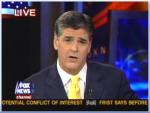 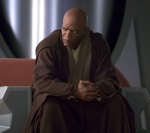 Mace Windu, the greatest hypocrite of them all, begins leading the Jedi Council down "a dark path" (as Yoda himself calls it) when he makes illicit moves against the Chancellor that oppose the very Jedi Code itself. This hypocrisy makes Anakin go crazy, considering Mace Windu is one of the strictest and most unrelenting Jedi in the Order. Like all other youths, Anakin does not stand for this blatant contradiction between creed and act, and objects, saying, "It's not the Jedi way!" right when Windu is about to execute Palpatine without due process. But Master Windu right then is conquered by the indignant passions he had once condemned. At that point, he practically joins the Dark Side - just as conservatives and liberals ultimately end up on the same side, opposite extremes, though still at war with each other and the truth. So, after Anakin kills Windu and rescues Palpatine in an effort to uphold Jedi Code as well as his emotions for Palpatine, what is left for him? Windu proves the old Jedi are no better than the Sith, for they are both willing to bypass creed for the sake of passion, so why not be honest about it and just turn to the Dark Side?
Mace Windu, the greatest hypocrite of them all, begins leading the Jedi Council down "a dark path" (as Yoda himself calls it) when he makes illicit moves against the Chancellor that oppose the very Jedi Code itself. This hypocrisy makes Anakin go crazy, considering Mace Windu is one of the strictest and most unrelenting Jedi in the Order. Like all other youths, Anakin does not stand for this blatant contradiction between creed and act, and objects, saying, "It's not the Jedi way!" right when Windu is about to execute Palpatine without due process. But Master Windu right then is conquered by the indignant passions he had once condemned. At that point, he practically joins the Dark Side - just as conservatives and liberals ultimately end up on the same side, opposite extremes, though still at war with each other and the truth. So, after Anakin kills Windu and rescues Palpatine in an effort to uphold Jedi Code as well as his emotions for Palpatine, what is left for him? Windu proves the old Jedi are no better than the Sith, for they are both willing to bypass creed for the sake of passion, so why not be honest about it and just turn to the Dark Side?
It is because of such hypocrites like Mace Windu that the Jedi are discredited. It was because of ongoing, insensitive, repressive conservatism that many fell away from Catholicism.
All this indicates that the Jedi Order needs reform. The ease, however, with which the Sith takes over the Republic proves that the Jedi Knights were weak and in need of such reform, just as it proved the Church was in need of repair when the Liberals effectively hijacked the Council's power in the years following it. The Church Council was the medicine, not the disease; but since the Body of Christ was so ill and weak, the medicine caused a violent reaction and became a poison of the Body. But not for long ...
|
Darth Vader is the Spirit of Vatican II
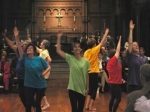  Despite his grievous sins during his padawan years, the point at which Anakin takes a knee before the Dark Lord and says, "I submit myself to your teachings," comes to us as rather unbelievable and insufficiently transitioned. Yet, in an eerie way, isn't this what suddenly happened to our beloved Council after its closing in the late 1960's? Didn't it immediately become the very tool of Satan to destroy the Church, as the Emperor implemented Anakin to destroy the Galactic Republic?
Despite his grievous sins during his padawan years, the point at which Anakin takes a knee before the Dark Lord and says, "I submit myself to your teachings," comes to us as rather unbelievable and insufficiently transitioned. Yet, in an eerie way, isn't this what suddenly happened to our beloved Council after its closing in the late 1960's? Didn't it immediately become the very tool of Satan to destroy the Church, as the Emperor implemented Anakin to destroy the Galactic Republic?
The answer is: yes. Vatican II was seduced by the dark side. In the council's name, the liberals destroyed the seminaries and gutted the churches. What is the first thing Palpatine commands Anakin to do? Purge the Jedi Temple. Slaughter the padawans in training. The Jedi nearly become extinct, as do the priests. Vatican II's name will live in infamy in the hearts and minds of a lot of faithful Catholics henceforth, just as Vader's name will live in the rebels, who sought to restore the old ways, before the dark times ... before the Empire.
Obi-Wan, upon seeing the ruins of his fallen apprentice after their duel, breaks his stoic mood and pours out his soul, hopeless, confused, shouting, "You were the Chosen One! You were suppose to bring balance to the Force! Not leave it in darkness!" Paul VI, likewise, in the midst of the aftermath, at a papal audience, suddenly broke with his character, threw down his prepared notes, and cried out, "Where is the love for the Church?!" Where was it indeed? What had happened?
A particularly interesting theme stressed throughout the Star Wars saga is the idea that Anakin Skywalker and Darth Vader are different people. Both Anakin and Vatican II take on personas - masks - behind which their true natures remain good, though the extrinsic elements imposed on them by their seducers direct them against themselves and their true purpose. I'm not denying the volition or responsibility of Anakin's choices; I'm just noting how interesting it is that Anakin Skywalker ceases to be Anakin Skywalker but, rather, Darth Vader. The Emperor explicitly changes his name upon his ordination, and later on, Obi-Wan refers to these two names as two different people. Likewise, and most importantly, in Return of the Jedi, Luke tells Vader, "You were once Anakin Skywalker, my Father," and the Dark Agent then turns to him and says, "That name no longer has any meaning for me," to which Luke replies, "It is only the name of your true self you've only forgotten ... I feel the good in you."
This distinction between "Anakin" and "Vader" is the same difference between "Vatican II" and the "Spirit of Vatican II." The former is the true self that has only been forgotten, the latter is the name of the evil menace wearing the mask that loyally serves the dark forces plaguing the Church. Luke thus considers his father to be the kind of thing many faithful Catholics consider Vatican II to be ... intrinsically good but something which was used for evil but can nonetheless be redeemed and used for good again.
Why does Anakin fall so quickly from the Light? Is he fulfilling his call as "Chosen One" by becoming evil, so as to balance the force between good and evil? I hope not. That would be flagrantly Gnostic. Just keep reading.
|
Queen Amidala (Padme) is the Pre-Conciliar Church
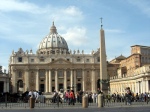  Queen Amidala, in an attempt to rescue her people on planet Naboo, worked toward reform in the Galactic Republic, as the Church's people needed rescuing before Vatican II. This is because, for example, the Church was becoming besieged by Capitalists who wanted to take her over but who nonetheless claim they are not technically opposing the Church, just as the Trade Federation claimed their blockade of Naboo was "perfectly legal." However, her efforts to reform things seemed to have made things worse ... as her support when to Chancellor Palpatine ... i.e. Modernism.
Queen Amidala, in an attempt to rescue her people on planet Naboo, worked toward reform in the Galactic Republic, as the Church's people needed rescuing before Vatican II. This is because, for example, the Church was becoming besieged by Capitalists who wanted to take her over but who nonetheless claim they are not technically opposing the Church, just as the Trade Federation claimed their blockade of Naboo was "perfectly legal." However, her efforts to reform things seemed to have made things worse ... as her support when to Chancellor Palpatine ... i.e. Modernism.
Padme, furthermore, was the woman Anakin was supposed to love and serve, but instead he betrayed her ... just as Vatican II appeared to betray the Church. Her death represents the kind of apparent death the Church underwent after the Council. It looked like the Church was at its end. Palpatine makes Vader forget about Padme and their offspring, telling him they all died, just as Modernism sought to divorce the memory of the Church from the aims of Vatican II completely.
However, despite all the chaos, there was hope. Padme gave birth to Luke and Leia, just as Vatican II gave birth to ... well, you'll see ...
|
Owen and Beru Lars (Luke's Uncle and Aunt) are Disenchanted and/or Traditionalist Catholics
  As many Catholics who were scandalized by the fallout of Vatican II and bitter at the pontificate of Paul VI, so are Owen and Beru Lars extremely (and overly?) worrisome about the Empire as well as about Obi-Wan Kenobi, whom they no doubt see as (at least) the partial cause of Darth Vader. They are the kind of people who, while hating the great evils in society, nonetheless try and hold people back from fixing them out of a small-minded, misplaced paranoia. The Lars hold Luke back from learning the Jedi ways, just as many extremist Catholics hold back others from learning what their faith actually says.
As many Catholics who were scandalized by the fallout of Vatican II and bitter at the pontificate of Paul VI, so are Owen and Beru Lars extremely (and overly?) worrisome about the Empire as well as about Obi-Wan Kenobi, whom they no doubt see as (at least) the partial cause of Darth Vader. They are the kind of people who, while hating the great evils in society, nonetheless try and hold people back from fixing them out of a small-minded, misplaced paranoia. The Lars hold Luke back from learning the Jedi ways, just as many extremist Catholics hold back others from learning what their faith actually says.
|
The Sand People (a.k.a. Tusken Raiders) are Muslims
  Both are desert-dwelling backwater people who terrorize others and steal technology from people to then use it against them. Exactly. That's stereotypical though ... obviously, some Sand People aren't like that.
Both are desert-dwelling backwater people who terrorize others and steal technology from people to then use it against them. Exactly. That's stereotypical though ... obviously, some Sand People aren't like that.
|
Luke Skywalker is John Paul II
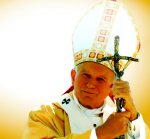  John Paul II, the New Pope, the Witness to Hope, was a child of the Council, as Luke is a child to Anakin Skywalker. Luke contains that humanism and emotion that his father had - seen in his boyish enthusiasm and care for his friends. At first his emotionality is uncontrolled and incredibly annoying, just like many liturgies in churches after the Council. But eventually he molds it successfully with his Jedi nature. He accomplishes what the second Vatican Council had set out to do: to bring that humanism into the spirit of the divine institution with a right, golden, harmonious balance. John Paul II had that same quality, possessing both the loving heart of a Christian humanist and the powerful mind of a Catholic theologian. This was the perfect combination to bring back the original aim of the Council.
Luke, furthermore, was almost killed by the Sand People, just as John Paul II was almost killed by the Nazis (and Communists for that matter), who had incidentally been largely influenced by Muslims (due largely to the Germans being allied with the Ottoman Empire back in World War I). Furthermore, John Paul II was shot and almost killed by none other than a Muslim.
John Paul II, the New Pope, the Witness to Hope, was a child of the Council, as Luke is a child to Anakin Skywalker. Luke contains that humanism and emotion that his father had - seen in his boyish enthusiasm and care for his friends. At first his emotionality is uncontrolled and incredibly annoying, just like many liturgies in churches after the Council. But eventually he molds it successfully with his Jedi nature. He accomplishes what the second Vatican Council had set out to do: to bring that humanism into the spirit of the divine institution with a right, golden, harmonious balance. John Paul II had that same quality, possessing both the loving heart of a Christian humanist and the powerful mind of a Catholic theologian. This was the perfect combination to bring back the original aim of the Council.
Luke, furthermore, was almost killed by the Sand People, just as John Paul II was almost killed by the Nazis (and Communists for that matter), who had incidentally been largely influenced by Muslims (due largely to the Germans being allied with the Ottoman Empire back in World War I). Furthermore, John Paul II was shot and almost killed by none other than a Muslim.
|
Princess Leia is the Post-Conciliar Church
 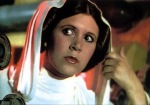 Leia carries on the fight against the Empire (i.e. the Sith), despite overwhelming odds, just as the Church continued to fight against modernism. Darth Vader sought to stop her, just as the Spirit of Vatican II sought to thwart the efforts of the Church.
Leia carries on the fight against the Empire (i.e. the Sith), despite overwhelming odds, just as the Church continued to fight against modernism. Darth Vader sought to stop her, just as the Spirit of Vatican II sought to thwart the efforts of the Church.
Furthermore, she first starts out a little feministic, just as the Church became so after Vatican II, but gradually becomes more feminine as masculine leaders finally begin living their heroic callings.
|
Han Solo is the Laity
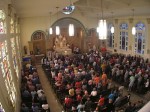  Part of Council's goal was to incorporate the laity more fully into the life of the Church and show that they, too, play an important role. Han Solo, likewise, does not want anything to do with the Rebellion or the Princess and refers to the Force as a "Hokey religion." Eventually, however, by Luke's encouragement, Han rescues the Princess, enters into the Rebel Alliance, and helps rescue it at a crucial moment in its history. Moreover, he falls in love with Leia, the Church, and then becomes frozen in Carbonite, which represents the death and resurrection of baptism, after which he is united to Leia, just as converts are united to the Church at baptism.
Part of Council's goal was to incorporate the laity more fully into the life of the Church and show that they, too, play an important role. Han Solo, likewise, does not want anything to do with the Rebellion or the Princess and refers to the Force as a "Hokey religion." Eventually, however, by Luke's encouragement, Han rescues the Princess, enters into the Rebel Alliance, and helps rescue it at a crucial moment in its history. Moreover, he falls in love with Leia, the Church, and then becomes frozen in Carbonite, which represents the death and resurrection of baptism, after which he is united to Leia, just as converts are united to the Church at baptism.
(As a side note, Han Solo also has a curious connection to St. John the Evangelist. First of all, "Han" is an alternate of "John" ... and "Solo" means "Alone," which I say somewhat groundlessly, may allude to John the Evangelist being alone among the apostles at one point, namely the only apostle to resist running away from Christ's crucifixion. However, in perhaps the most explicit crucifixion-like scene in Star Wars was in Empire Strikes Back, Han Solo acts as a Christ-figure, namely when he is about to be frozen in carbonite only to eventually be resurrected later (he also gets tied to a thing and injected with some painful needless, alluding perhaps to the Scourging). However, Han tells Chewbacca to take care of Leia right before he gets frozen, similar to how Christ tells St. John to take care of Mary. Lastly, the Millennium Falcon, Han's ship, might be connected to St. John's traditional iconographic symbol of an Eagle, since Falcons and Eagles are related species. I don't know if this perceived St. John connection also relates to the Laity theory, but if anyone can figure it out, please let me know.)
|
Chewbecca is Man's Animalistic Passions
  Chewbacca, a seemingly irrational beast on the surface, is at first hostile to various good characters (such as Luke), just as man's disordered passions are repulsed by goodness (and by the Pope who uncomfortably calls men to live lives of virtue). Furthermore, Chewbacca is closely associated with Han Solo more, such as human passions are more closely associated with the laity. But, as struggles are won, Chewbacca not only aids Luke but develops a dog-like affection for him. This helps further to symbolize the overall efforts of Vatican II, namely to integrate the Church's message into men's hearts (which includes their passions).
Chewbacca, a seemingly irrational beast on the surface, is at first hostile to various good characters (such as Luke), just as man's disordered passions are repulsed by goodness (and by the Pope who uncomfortably calls men to live lives of virtue). Furthermore, Chewbacca is closely associated with Han Solo more, such as human passions are more closely associated with the laity. But, as struggles are won, Chewbacca not only aids Luke but develops a dog-like affection for him. This helps further to symbolize the overall efforts of Vatican II, namely to integrate the Church's message into men's hearts (which includes their passions).
|
The Death Star is the Culture of Death
  The Death Star symbolizes the Culture of Death, a whole world bent on universal conquest and purposed for the murder of millions of innocent lives, as it senselessly destroys Alderaan, a planet that is completely defenseless, without any weapons. Paul VI, when the Culture of Death began to take shape, as it were, heard the "millions of voices [that] suddenly cried out, and were suddenly silenced" as Obi-Wan said when he sensed the planet's destruction - a perfect image of abortion. Alderaan, furthermore, is Leia's planet, and thus, symbolically, the Church's people, and the loss of so many lives on it represents the loss of so many souls in the Church because of abortion.
The Death Star symbolizes the Culture of Death, a whole world bent on universal conquest and purposed for the murder of millions of innocent lives, as it senselessly destroys Alderaan, a planet that is completely defenseless, without any weapons. Paul VI, when the Culture of Death began to take shape, as it were, heard the "millions of voices [that] suddenly cried out, and were suddenly silenced" as Obi-Wan said when he sensed the planet's destruction - a perfect image of abortion. Alderaan, furthermore, is Leia's planet, and thus, symbolically, the Church's people, and the loss of so many lives on it represents the loss of so many souls in the Church because of abortion.
The heroes involved with saving the Church from the Culture of Death, i.e. rescuing Leia from the Death Star, was Paul VI, John Paul II, and the faithful Catholic laity ... that is, Obi-Wan Kenobi, Luke Skywalker, and Han Solo.
The way to destroy the Culture of Death is, paradoxically, by means of more life ... that is, by sex, impregnation ... and so forth. At the battle of Yavin, the rebels intend to symbolically do just that ... namely (hear me out on this one) ... have sex with the Death Star. Oh, man, I've really lost it haven't I? The rebel starfighters attempt to shoot proton torpedos (which vaguely look like sperm) into a small exhaust port (which, I'll just say it, represents the vaginal opening). Furthermore, the rebel's ships are called X-Wings and Y-Wings ... which, of course, represent X Chromosomes and Y Chromosomes (i.e. the sex-determining structures of DNA involved in reproduction). Moreover, imperial TIE Fighters, which represent contraception (i.e. TIEing one's tubes ... and later on TIE "Interceptors" which sound like "Contraceptors"), try to destroy them to prevent this symbolic act of impregnation.
While Luke is narrowing in on the target with his targeting computer, Obi-Wan mystically tells him to "let go" and just "use the force," as the computer is destined to fail. In other words, Obi-Wan is encouraging a natural method for this act rather than an artificial one. Luke obeys him, and it works. This, of course, parallels how Paul VI advocated natural sex as opposed to artificial birth control, and John Paul II followed his predecessor in this. John Paul II thus helped to blow up of the Culture of Death with his ... yes, that's right ... Theology of the Body (his pivotal work explaining to the modern mind the correct view one should have with regard to human sexuality).
Fittingly, as the torpedos successfully enter the exhaust port which cause the destruction of the Death Star, Luke gives a satisfying and almost orgasmic sigh of relief (and just FYI, this is not to symbolize John Paul II having sex, but merely people having truly satisfying sex as a result of John Paul II's theology).
If you think I'm off the wall on this one, I don't blame you. I'm probably crazy.
|
Yoda is Sacred Tradition (and little "t" tradition)
 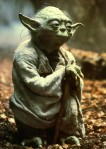 Yoda is hundreds of years old and in possession of the ancient knowledge of the Jedi, just as Sacred Tradition contains divine revelations dating back to Christ. From him, Luke learns the ancient aspects of the Force, just as John Paul II would be horribly missing something without having united himself with Church Tradition. However, Yoda by himself is not enough, just as tradition is not enough, just as Yoda was not able to defeat the Emperor (in Episode 3), and, similarly, Catholics who focus too much on tradition fall into error (people often called "Traditionalists") and merely become reclusive and disenchanted by the destruction around them. The parts of Yoda that have grown genuinely "out of touch" with the world (and in need of the prophesied "balance") falls under small "t" tradition (i.e. the particular, fallible habits of the former age). Luke still retains a heed to his human emotion, though Yoda, in accord with the anti-humanistic tendency of the previous Jedi, tries to squash it, condemning certain emotions like anger and fear as evil, claiming they lead to the dark side of Force. This is what many Traditionalists (who also fail to distinguish big "T" from little "t" tradition) tend to think too, that human affections are evil, but they in the end shall be proved wrong, just as Yoda was.
Yoda is hundreds of years old and in possession of the ancient knowledge of the Jedi, just as Sacred Tradition contains divine revelations dating back to Christ. From him, Luke learns the ancient aspects of the Force, just as John Paul II would be horribly missing something without having united himself with Church Tradition. However, Yoda by himself is not enough, just as tradition is not enough, just as Yoda was not able to defeat the Emperor (in Episode 3), and, similarly, Catholics who focus too much on tradition fall into error (people often called "Traditionalists") and merely become reclusive and disenchanted by the destruction around them. The parts of Yoda that have grown genuinely "out of touch" with the world (and in need of the prophesied "balance") falls under small "t" tradition (i.e. the particular, fallible habits of the former age). Luke still retains a heed to his human emotion, though Yoda, in accord with the anti-humanistic tendency of the previous Jedi, tries to squash it, condemning certain emotions like anger and fear as evil, claiming they lead to the dark side of Force. This is what many Traditionalists (who also fail to distinguish big "T" from little "t" tradition) tend to think too, that human affections are evil, but they in the end shall be proved wrong, just as Yoda was.
Yoda, as well as Obi-Wan's ghost (who also takes on the persona of a sad trad, which Paul VI was at least maybe likely to adopt at the end of his life too) also tries to destroy Luke's predominant feeling of human affection. Think of it. Yoda and Obi-Wan's Ghost want Luke to destroy Darth Vader, just as some trads want to destroy Vatican II, believing it cannot be salvaged from the machinery added on to it by the Liberals. But Luke wants to bring him back, saying, "I can't kill my own father." So too John Paul II couldn't simply invalidate a legitimate Church Council: rather he sought to reclaim it from liberal malefactors. Obi-Wan simply replies, "Then the Emperor has already won. You were are last hope." Or really Obi-Wan? Turns out you were wrong!
|
R2-D2 is Sacred Scripture
  R2 contains the Death Star plans, the only truth capable of their salvation ... just like Scripture still has the truth which will save us from the Culture of Death.
R2 contains the Death Star plans, the only truth capable of their salvation ... just like Scripture still has the truth which will save us from the Culture of Death.
|
C-3PO is the Magisterium
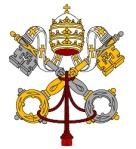 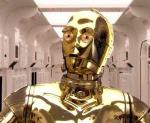 C-3PO representing the Magisterium who interprets Scripture (just as C-3PO interprets the often baffling beeps and whistles of R2-D2), knows more than anyone else, and is really annoying to some people. His golden finish, furthermore, can symbolize the golden key on the Papal insignia representing the Pope's spiritual authority.
C-3PO representing the Magisterium who interprets Scripture (just as C-3PO interprets the often baffling beeps and whistles of R2-D2), knows more than anyone else, and is really annoying to some people. His golden finish, furthermore, can symbolize the golden key on the Papal insignia representing the Pope's spiritual authority.
Just as Sacred Scripture, Tradition, and the Magisterium are constants throughout the Church, so are Yoda, R2-D2, and C-3P0 appear in all six movies (well, Yoda doesn't appear in Episode 4, I admit ... close enough).
|
Lando Calrissian is a Racially Persecuted Minority in the Church (e.g. African Americans)
  Lando Calrissian (and this is sketchy at best) represents the black community in the Church, who having been dealt a bad hand (which is what happened to Lando in a card game that lost him The Millennium Falcon to Han Solo), makes a deal with the Empire and betrays the rebels for his own security and perhaps out of past jealousy, just as the black population seems to take sides with Liberalism against the Church, which they think will offer them protection against racists. This creates bitterness between blacks and other members of the Church, just as Lando is so scorned by Han and Leia. But realizing that Modernism is more racist and dangerous to blacks than the Church is, the blacks will have a change of heart and will begin to aid the Church, as Lando does to the Rebels. This is what is happening in Africa and hopefully in America, as Liberalism continues to grow more apathetic to racist issues.
Lando Calrissian (and this is sketchy at best) represents the black community in the Church, who having been dealt a bad hand (which is what happened to Lando in a card game that lost him The Millennium Falcon to Han Solo), makes a deal with the Empire and betrays the rebels for his own security and perhaps out of past jealousy, just as the black population seems to take sides with Liberalism against the Church, which they think will offer them protection against racists. This creates bitterness between blacks and other members of the Church, just as Lando is so scorned by Han and Leia. But realizing that Modernism is more racist and dangerous to blacks than the Church is, the blacks will have a change of heart and will begin to aid the Church, as Lando does to the Rebels. This is what is happening in Africa and hopefully in America, as Liberalism continues to grow more apathetic to racist issues.
|
Boba Fett (and Jengo Fett) is Radical Individualism
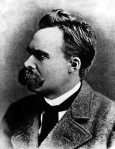  The philosopher Friedrich Nietzsche promoted the idea that people should act only out of their own selfish desires, without any reference to concepts of good and evil (which he said were only lies). Likewise, the image of a Bounty Hunter (of which the character of Boba Fett belongs) implies an individualistic lifestyle, the lack of allegiance to any authority, the freedom to chose to do whatever one wants, and a license to do things that would normally be considered immoral (e.g. killing). Also, both have a strange appeal to people, as Nietzsche, despite his flagrant condemnation of morality, nonetheless fosters in some of the most moral people a kind of dark attraction ... likewise Boba Fett, though being a very minor character who doesn't do anything good, might be the most popular character among Star Wars fans. Furthermore, Boba Fett is the one to capture and imprison Han Solo, just as Radical Individualism has enslaved much of the laity.
The philosopher Friedrich Nietzsche promoted the idea that people should act only out of their own selfish desires, without any reference to concepts of good and evil (which he said were only lies). Likewise, the image of a Bounty Hunter (of which the character of Boba Fett belongs) implies an individualistic lifestyle, the lack of allegiance to any authority, the freedom to chose to do whatever one wants, and a license to do things that would normally be considered immoral (e.g. killing). Also, both have a strange appeal to people, as Nietzsche, despite his flagrant condemnation of morality, nonetheless fosters in some of the most moral people a kind of dark attraction ... likewise Boba Fett, though being a very minor character who doesn't do anything good, might be the most popular character among Star Wars fans. Furthermore, Boba Fett is the one to capture and imprison Han Solo, just as Radical Individualism has enslaved much of the laity.
Ironically, if you look at Boba Fett objectively, he really never does anything very spectacular in the movies. Likewise, if you look at Friedrich Nietzsche, he led a very pathetic life, eventually descending into a pathetic insanity (kind of like how Boba Fett descended into the Pit of Sarlacc to be digested over a thousand years). In addition, Boba Fett, despite his alleged non-alignment, is simply a servant of the Empire and obeys their orders, just as Individualists seem to, almost out of obligation, align themselves against the Church.
|
Stormtroopers (and Clone Troopers) are Radical Conformity
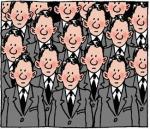  Another irony about Jengo Fett and Boba Fett is that their DNA was used to spawn the army of soldier Clones for the Galactic Republic and eventually the Stormtroopers of the Galactic Empire. These soldiers, of course, appear nearly mindless and rather slave-like. Similarly, the result of people trying to be Individualistic is that ... they conform to the same model. Moreover, they become enslaved to their passions and follow whoever will promises fulfillment of them ... or as time progresses, whoever is the strongest.
Another irony about Jengo Fett and Boba Fett is that their DNA was used to spawn the army of soldier Clones for the Galactic Republic and eventually the Stormtroopers of the Galactic Empire. These soldiers, of course, appear nearly mindless and rather slave-like. Similarly, the result of people trying to be Individualistic is that ... they conform to the same model. Moreover, they become enslaved to their passions and follow whoever will promises fulfillment of them ... or as time progresses, whoever is the strongest.
|
Jabba the Hutt is Nihilistic, Worldly Hedonism
  Jabba, a huge alien slug (Phallic symbol?), in his dark and murderous pleasure palace, lusts for females of different species ... a nice symbol for the sexual excess and deviance of the Modernist world.
Jabba, a huge alien slug (Phallic symbol?), in his dark and murderous pleasure palace, lusts for females of different species ... a nice symbol for the sexual excess and deviance of the Modernist world.
Once again, Boba Fett, the model of Individualism, is actually shown as a kind of servant for Jabba, just as Individualists are simply slaves to their passions.
Most importantly, we see Han Solo bound to Jabba due to a past debt, just as the laity is more often enslaved by the desires of the flesh, which, if they don't deal with the problem, will become frozen in their sin. As Han is rescued by Leia and Luke, so were many lay people rescued from sexual and material slavery by the Church and, notably, John Paul II. The moral teaching of the Popes incites much unholy anger from hedonists, just as Jabba tried killing Luke with his monstrous creature (which was called a Rancor ... hence, the anger allusion) under his trapdoor. Furthermore, Leia, the Church, eventually kills him, just as it is through the Church that the sins of the flesh are overcome.
|
Ewoks are the Catholic Youth
  The Ewoks' small, teddy-bear-like appearance and alliance with the Rebellion correlate them with the children who have the Catholic faith.
The Ewoks' small, teddy-bear-like appearance and alliance with the Rebellion correlate them with the children who have the Catholic faith.
First, in their uneducated confusion, Ewoks were hostile to Leia and her friends, just as teenagers after Vatican II thought the Church was uncool and didn't care what the Pope had to say. However, the Ewoks were converted thanks to the divine-like shininess of C-3PO who, with the guidance of Luke Skywalker, were able to befriend them, just as even teenagers can become attracted by light of truth in Catholicism (via the Magisterium) and strongly became so under the Pontificate of John Paul II. It will be through the younger generation going over to the Church's side that the Culture of Death will be vanquished. The Ewok attack on the most well-trained Imperial legion rather implausibly worked and was instrumental in the Death Star's destruction, just as World Youth Days, which can be just as annoying as a rabble of Ewoks, make a surprisingly good impact on the culture.
|
|
The Defeat of the Empire is the Defeat of Modernism
What defeats Darth Vader? Emotion. Emotion directed toward the good. First it is anger, when Luke explodes in holy wrath at Vader's threat to convert Leia to the Dark Side, severing off the Dark Lord's hand in justice. Does Luke fall to the Dark Side because of it? No. The Emperor tries to make him think that he had fallen, as Yoda had taught him that anger is evil, but Luke, after a bit of rational contemplation, realizes that his anger was righteous and not sinful. Furthermore, what converts Darth Vader back to the Light Side? Human affection. Luke, under Palpatine's Force Lightning, cries out desperately to his father, yelling, "Father! Please!" and Vader's dark heart is moved by his son's love.
Surprisingly, in the end, Anakin Skywalker does turn out to be the Chosen One, as he is the one to destroy the Sith, throwing the Emperor down the bottomless shaft, and by the aid of Luke, the ways of the Jedi are harmoniously restored and reunited with the neglected goodness of the human person. Just now, we are beginning to see a rebirth in the Church with a correct implementation of the Council, which, hopefully, shall throw the evils of modernism down to the abyss as well (though remnants may endure, as there are remnants of the Empire still buzzing around after Return of the Jedi ... but whatever).
Vatican II, since it was an ecumenical council of the Catholic Church, was perhaps the most important event of the 20th century. Likewise, such a thing can be similarly stated about Star Wars (i.e. it was really important). Despite its pop culture appeal, there's something about it that speaks to people and continues to do so (even though the prequels sucked ... though Revenge of the Sith wasn't so bad).
As Pope Benedict XVI calls for a correct hermeneutic (interpretation) of the Second Vatican Council, I hope that I have provided a correct hermeneutic of Star Wars. If you don't think so, then rebel.
May the Lord be with you. Always.
|
By Julian Ahlquist. Originally posted on Vestal Morons.
|


